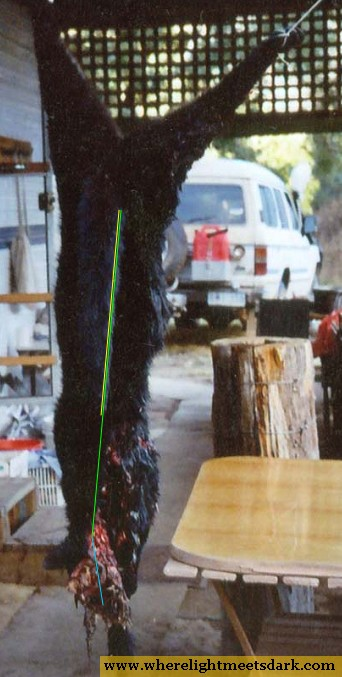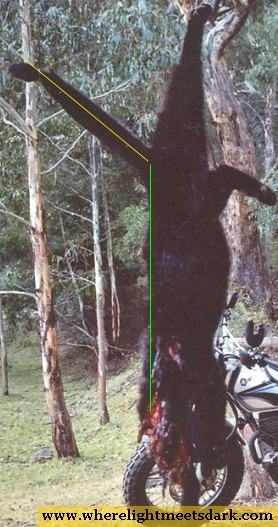Engel Gippsland big cat
Warning - disturbing images follow
Cryptozoologist Mike Williams, who maintains an Australian Big Cats blog, approached Where Light Meets Dark in October 2006 to help with an analysis of the Gippsland big cat photographs. Williams was approached for comment by the Australian Herald Sun (with the article being reproduced on the Snopes forums) at the time and said that Engel had "proved all the hundreds of farmers have been telling the truth."
To check the breed of cat, a DNA sample was sent internationally for analysis. Many were surprised, when it was finally reported to be a giant feral domestic cat (Felis catus). Whilst the breed is surprising, Williams was not wrong to say that farmers had been seeing big cats.
So just how big was our feral moggie?
← Click to enlarge
The Gippsland Big Cat - a World Record!
This analysis is fairly straightforward. Williams was able to obtain the length of the tail - that being 60 centimeters. Given that in this photograph, the tail is laid practically along the spine of the animal, we can make a direct comparison between the tail length and the spine and then the head of the animal.
The yellow line traces the animal's tail.
The green line traces the spine.
The blue line traces the head.
The following measurements can then be concluded:
Tail (base of tail to tip of tail) = 60 cm (given).
Spine (base of tail to base of neck) = 96cm (calculated).
Head (horizontal distance from base of neck to tip of nose) = 20cm (calculated).
Therefore, the length of this cat from the tip of its nose to the base of its tail, is 116cm.
The total length, from tip of nose to tip of tail, is then approximately 176 centimeters - nearly 6 foot.
According to Guiness World Records, the longest domestic cat on record measures in at 121.9cm from nose to tail.
Given the positive DNA analysis (that this is a domestic cat), and even accounting for the approximation of the measurement, this means the Gippsland Big Cat is a world record breaker!
No doubt this will fuel the debate even further regarding the status of other cats such as pumas and leopards in Australia. If a moggie can grow to this size, then can all Australian big cat sightings be explained by feral domestics?
We all know Australia has many problems with feral species, including feral cats, but this one just got a whole lot bigger!
← Click to enlarge
Postscript
After publishing the above text, I noticed that the appearance of the tail in this photograph may not be as clear as I had at first presumed. Specifically, it may be longer than I have measured using the yellow line.
As a result, the above measurements may be an over-estimation.
To cross check the calculations, I have again applied the known length - which is the 60 centimeter tail - to the second photograph as seen here.
Again, the yellow line traces the tail, and the green line traces the spine. The end-point of the green line is at approximately the same place as depicted in the first photo (using the bullet exit wound for comparison).
This results in the following measurements:
Tail (base of tail to tip of tail) = 60 cm (given).
Spine (base of tail to base of neck) = 91cm (calculated).
This measurement of the tail is 5.12% shorter than the first. Applying this level of error to the original head measurement gives an estimated head length of 19cm.
Thus, from the second photo, the animal's full length, from tip of nose to tip of tail is 170cm.
As a result of both analyses considered together, the length of this cat from nose to tip of tail is approximately 170 - 176cm and well in excess of the longest recorded domestic cat (which measured approximately 122cm).

